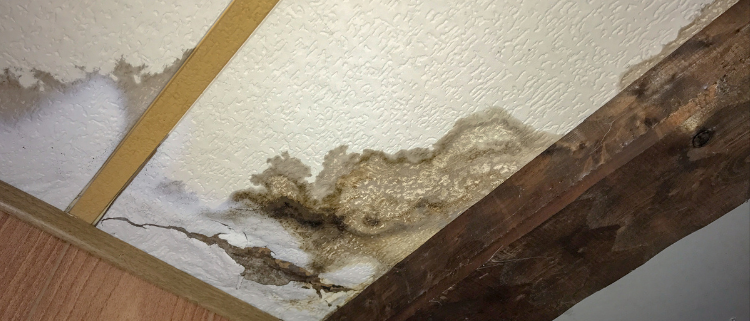Common Causes of Leaky Ceilings in Natick, MA
Homeownership comes with as many challenges as it does fun surprises. One of the less exciting parts of being a homeowner is dealing with water damage restoration. Unfortunately, this is all too common for many people, especially since water damage can come from a variety of sources.
While most people think of flooding floors when they think of water damage, it can also be hidden in other parts of the home, including the ceiling. It might seem like this type of water damage would be easy enough to spot, but it’s usually a slow leak rather than an unwanted waterfall installation.
What causes these slow leaks?
Ceiling water damage isn’t limited to one source. There are many factors that can contribute to a leaky ceiling, but the following are some of the most common culprits that require water damage restoration services.
Old Roofs
The average lifespan of a roof can range anywhere from 25 to 50 years, depending on the type of roofing system. For example, metal roofs last much longer than asphalt. However, all roofs are subject to wear and tear that can cause them to degrade over time. Not only can the material weaken, but caulking around the flashing can also crack and break off.
Eventually, the roofing system becomes more vulnerable to the elements. For that reason, it’s important to regularly inspect a roof to make sure that it is still in good shape. Otherwise, the home might end up with significant water damage in the attic or ceilings.
Damaged or Missing Shingles
Even if a roof isn’t old, it can still sustain damage from storms, especially if heavy wind or hail is involved. This severe weather can damage or entirely remove large portions of shingles from a roof. When this happens, the rain from the same storms can enter the home. If the shingles aren’t repaired quickly enough, rain and snowmelt can continue to make their way into the roof and damage the ceilings of the home.
Ice Dams
Another roofing problem that many water damage restoration companies discover is ice dams. Fortunately, this isn’t something that homeowners have to worry about in the warmer months, but homes in Natick, MA may become susceptible to ice dams if there are periods of heavy snow.
How does it happen?
When the sun heats the roof during the day, it can melt snow, but when temperatures drop in the evenings, that snowmelt can turn to ice. As this continues, the ice can build up underneath the shingles and create an ice dam. From there, it can leave the roof weakened and vulnerable to leaking.
Plumbing Problems
Damaged roofs aren’t the only culprit of leaking ceilings. Some homes may experience ceiling water damage if there are plumbing issues. For example, an upstairs bathroom can leak and destroy the ceiling below it. Homes may also experience a pipe burst in an upstairs room that leads to water damage in the basement ceiling or other levels.
In the case of a pipe burst, it’s usually easy to detect that there is a problem. Homeowners will either hear or see a rush of water. If there is a slow leak in the plumbing, it may be harder to detect, and ceilings could end up with mold.
Damaged Appliances
Finally, some homeowners might find that their faulty appliances are the cause of a leaky ceiling. It’s not uncommon for refrigerators, washing machines, and dishwashers to leak. The drain and supply lines can easily become damaged or clogged over time. When they finally end up leaking, the water can move to the ceiling of the room below it. Usually, this occurs slowly, and it can take a while to detect the water damage.
Signs a Ceiling Needs Water Damage Restoration
Since leaky ceilings usually don’t have a steady stream or drip of water, they can be difficult to detect until they’ve already wreaked havoc on the drywall, insulation, and framing of a house. For that reason, it’s important that homeowners understand what signs can indicate a problem so that they can catch the leak as quickly as possible. Signs that a ceiling might need a water damage restoration include:
- Discoloration or Staining
- Sagging Drywall
- Sagging Light Fixtures
- Blistering or Peeling Ceiling Paint
- Buckling or Cracking Plaster
- Holes in Drywall
- Mold or Mildew Odors
Find out More About the Common Causes of Water Damage Restorations for Ceilings
Homeowners who suspect that they have leaky ceilings shouldn’t hesitate to contact a water damage restoration company for a professional inspection. Skilled contractors like A.W. Puma Restoration & Remodeling can use their specialized tools to check for moisture in drywall, flooring, and more. Natick homeowners can reach their experts by calling (508) 406-7556, or they can send a message through the convenient online contact form.





